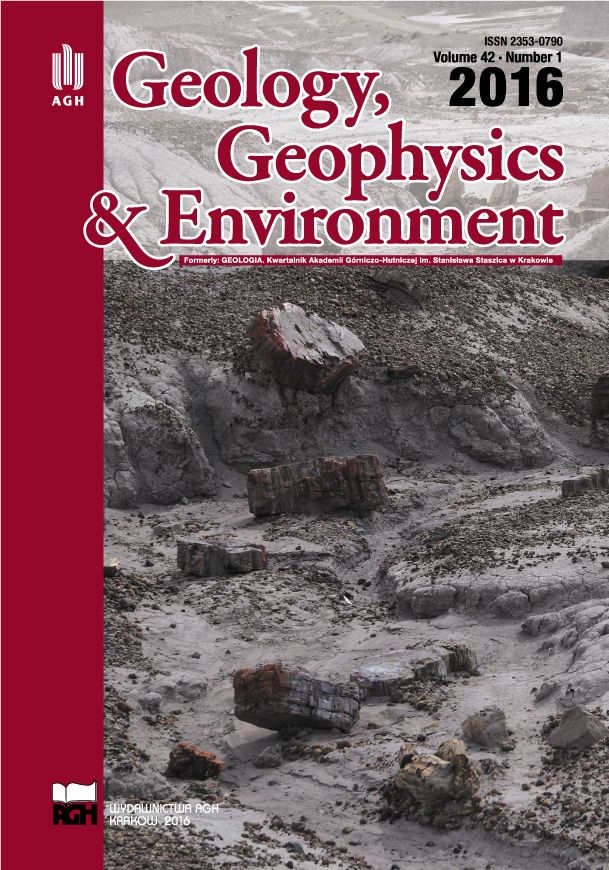Graph representation of geological stratum
DOI:
https://doi.org/10.7494/geol.2016.42.1.92Keywords:
graph database, geodatabaseAbstract
Geology, geophysics and environmental protection sciences provide large amounts of data. These data can be stored in various structures. Most are data files, often they are constructed database. One of the first databases for earth sciences is a Geokarpat database (Kotlarczyk et al. 1997). This solution was developed over many years (Piórkowski 2009). It was developed other geological databases, for example:: database MIDAS (MIDAS 2015), central database of the geological data (CBDG 2015). These examples are based on the relational data model. This model is not perfect for data analysis, where there are a lot of complicated relationships between the entities (Dominguez-Sal et al. 2010). Standard approach using SQL required in this case, the use of multiple joins. This approach requires a large amount of calculation.
Graph data model is gaining popularity because it allows representation similar to the natural model of the network of relationships between data (Horzyk 2013). Applications of this model for the earth sciences are extensive, including solutions for GIS systems. An example is the creation of a virtual generator of the city using database Neo4j (Pluciennik-Psota & Płuciennik 2014). Graph structure well reproduces biological structure of memory (Horzyk 2013). The use of these advantages for geological database enables new opportunities for storage and analysis of data.
Geological stratum often have a complex structure, for example, around area of tectonic faults. Possibility of graph databasewas was checked and verified potential applications in geology. This study focuses on proposing a graph representation of geological stratum. The proposed structure was implemented in the graph database. This representation has shown that analysis of complex models of geological stratum can be less complex. Research present that finding dependencies record in graph databases of geological layers is simpler than relational databases.
Downloads
References
CBDG, 2015. http://baza.pgi.gov.pl/
Dominguez-Sal, D., Urbón-Bayes, P., Giménez-Vañó, A., Gómez-Villamor, S., Martínez-Bazán, N., Lluís Larriba-Pey, J.: Survey of Graph Database Performance on the HPC Scalable Graph Analysis Benchmark. W: Shen, H.T., Pei, J., Özsu, M.T., Zou, L., Lu, J., Ling, T.-W., Yu, G., Zhuang, Y., i Shao, J. (red.) Web-Age Information Management. ss. 37–48. Springer, Berlin, Heidelberg (2010)
Horzyk, A.: Artificial Associative Systems and Associative Artificial Intelligence. EXIT, Warsaw (2013)
Kotlarczyk J., Krawczyk A., Leśniak T., Słomka T. 1997. Geologiczna baza danych GeoKar-
patydla polskich Karpat fliszowych. Wydawnictwo własne WGGiOŚ AGH, Kraków.
MIDAS, 2015. http://geoportal.pgi.gov.pl/portal/page/portal/MIDASGIS
Piórkowski A., Gajda W. 2009. A construction of multidimensional geological database, Studia Informatica, vol. 30 no. 2B, p. 179–190.
Pluciennik-Psota, E., Płuciennik, T.: Using Graph Database in Spatial Data Generation. W: Man-Machine Interactions 3. Springer International Publishing, Berlin (2014)
Downloads
Published
Issue
Section
License
Authors have full copyright and property rights to their work. Their copyrights to store the work, duplicate it in printing (as well as in the form of a digital CD recording), to make it available in the digital form, on the Internet and putting into circulation multiplied copies of the work worldwide are unlimited.
The content of the journal is freely available according to the Creative Commons License Attribution 4.0 International (CC BY 4.0)










